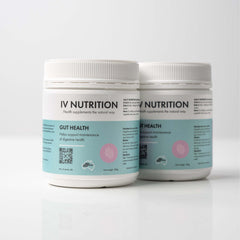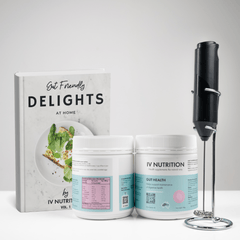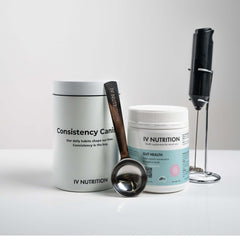Heartburn is one of the most common gastrointestinal complaints worldwide, with an estimated 15–30% of the population experiencing symptoms at least once a week (National Institute of Diabetes and Digestive and Kidney Diseases). Yet despite its prevalence, few people understand what heartburn actually is, why it happens, and—most importantly—how to make it go away effectively and sustainably.
In this science-backed, clinical guide, we’ll break down the mechanisms behind heartburn, how it's typically treated, the role of the gut microbiome in acid regulation, and how prebiotic fibers—especially sugarcane-derived types like IV Nutrition’s Virgin Manufactured Prebiotic Fibre—can help support long-term digestive balance.
What Is Heartburn?
Heartburn is a burning sensation in the chest that occurs when stomach acid backs up into the esophagus. It often feels like a sharp or fiery pain behind the breastbone and may radiate toward the throat.
This condition is often caused by gastroesophageal reflux—the flow of stomach contents back into the esophagus due to a weak or dysfunctional lower esophageal sphincter (LES), the muscular valve that separates the stomach from the esophagus.
When the LES fails to close properly, acid and digestive enzymes can leak upwards, leading to irritation and the characteristic burning sensation known as heartburn.
Common Causes of Heartburn
Understanding what triggers heartburn is essential to effectively manage or eliminate it. Key contributing factors include:
-
Overeating or lying down right after a meal
-
High-fat or spicy foods
-
Caffeine, alcohol, and carbonated beverages
-
Obesity or pregnancy, which increase abdominal pressure
-
Smoking, which relaxes the LES
-
Certain medications, including NSAIDs, calcium channel blockers, and sedatives
When Is Heartburn More Than Just Heartburn?
Occasional heartburn is common and usually harmless. However, chronic heartburn may indicate a more serious condition known as gastroesophageal reflux disease (GERD).
GERD is diagnosed when acid reflux occurs more than twice a week and interferes with daily life. If untreated, GERD can lead to:
-
Esophagitis (inflammation of the esophagus)
-
Esophageal ulcers or strictures
-
Barrett’s esophagus, a precancerous condition
-
Asthma-like symptoms, especially at night
A clinical diagnosis often requires upper endoscopy, esophageal pH monitoring, or manometry testing.
How Does Heartburn Go Away?
Heartburn can resolve in several ways—some are immediate, others longer-term. Here's what the medical literature says.
1. Natural Acid Clearance
In healthy individuals, the body naturally neutralizes stomach acid that escapes into the esophagus through:
-
Saliva, which contains bicarbonate
-
Swallowing, which pushes acid back into the stomach
-
Peristalsis, the rhythmic contractions of the esophagus
This process can usually resolve minor episodes within minutes to hours.
2. Lifestyle Adjustments
For many, lifestyle modification is the first-line treatment:
-
Eating smaller meals
-
Avoiding triggers (fatty, acidic, or spicy foods)
-
Not lying down within 2–3 hours after eating
-
Elevating the head of the bed by 6–8 inches
-
Losing excess weight
A meta-analysis in the American Journal of Gastroenterology showed that these strategies significantly reduce GERD symptoms when adhered to consistently.
3. Medications
Several types of medications help reduce or block acid production:
-
Antacids (e.g., Tums, Maalox): Provide fast relief by neutralizing stomach acid.
-
H2 blockers (e.g., ranitidine, famotidine): Reduce acid production.
-
Proton pump inhibitors (PPIs) (e.g., omeprazole, esomeprazole): Block acid production more effectively and are used for more persistent symptoms.
Long-term use of PPIs, however, can have side effects such as vitamin B12 deficiency, increased risk of kidney disease, and alterations in gut microbiota (BMJ Open Gastroenterology).
4. Surgery
For severe, medication-resistant GERD, surgical options like Nissen fundoplication or LINX device implantation may be considered.
The Gut Microbiome’s Role in Heartburn
Emerging research highlights the influence of the gut microbiome on gastrointestinal health and acid regulation. A balanced microbial environment helps maintain:
-
Stomach acid homeostasis
-
Gastric emptying speed
-
LES function
-
Inflammation levels in the esophageal lining
A disrupted microbiome (known as dysbiosis) may contribute to acid reflux through altered motility, bloating, and increased intra-abdominal pressure.
A 2021 study published in Microorganisms Journal found a significant association between gut dysbiosis and the prevalence of GERD, indicating that restoring gut balance may improve symptoms.
Prebiotics: A Natural Way to Support Digestive Health
While probiotics are often promoted for gut health, prebiotics are arguably more foundational. Prebiotics are non-digestible dietary fibers that feed the beneficial bacteria already present in your colon. They help:
-
Increase short-chain fatty acid (SCFA) production like butyrate, which reduces inflammation
-
Enhance gut motility
-
Promote the growth of acid-tolerant microbes like Lactobacillus and Bifidobacterium
-
Support immune function within the gut lining
According to the International Scientific Association for Probiotics and Prebiotics (ISAPP), daily intake of prebiotic fibers can significantly improve gut barrier integrity and overall microbiome balance.
Spotlight on Sugarcane-Derived Prebiotic Fibre
Among the various sources of prebiotics, sugarcane-derived fiber is emerging as a standout. Unlike processed fibers, virgin sugarcane prebiotic fibre is minimally processed, highly soluble, and packed with fermentable fibers that selectively nourish beneficial microbes.
Why It Works for Heartburn and Gut Health:
-
Increases gut microbial diversity, which stabilizes acid levels and enhances gut motility.
-
Supports regular bowel movements, reducing pressure on the LES.
-
Strengthens the intestinal lining, preventing inflammation that can exacerbate reflux.
-
Boosts butyrate levels, a SCFA shown to promote esophageal mucosal healing (Frontiers in Immunology).
Recommended Product: IV Nutrition’s Virgin Manufactured Sugarcane Prebiotic Fibre
We recommend IV Nutrition’s Virgin Manufactured Sugarcane Prebiotic Fibre—a premium-grade prebiotic supplement designed to support gut-brain and gut-digestive health.
Key Benefits:
-
Sourced from virgin sugarcane, free from pesticides and additives
-
Designed to nourish beneficial gut bacteria without bloating
-
Suitable for daily use in individuals with sensitive digestion
-
Aids in restoring gut balance, which can reduce reflux and heartburn flare-ups
Special Offer:
Get your first tub FREE when you subscribe.
Click here to claim the 100% off offer.
Practical Tips to Prevent and Reverse Heartburn Naturally
Here’s a science-backed checklist to reduce your risk of reflux and encourage healing:
1. Eat Mindfully
Slow down and chew thoroughly. Avoid overeating, especially during dinner.
2. Stay Upright After Eating
Remain seated or standing for at least two hours post-meal.
3. Balance Your Gut
Include prebiotic-rich foods like asparagus, leeks, onions, and prebiotic supplements like IV Nutrition’s formula.
4. Drink Water, Not Sodas
Hydration helps dilute acid, but fizzy drinks increase intra-abdominal pressure.
5. Manage Stress
Chronic stress alters gut function and acid levels. Mindfulness, CBT, and breathing exercises can help.
Visual Guide: Lifestyle vs Medical Approaches to Heartburn
| Treatment Type | Mechanism | Time to Relief | Long-Term Effects |
|---|---|---|---|
| Antacids | Neutralizes existing acid | Minutes | Temporary |
| H2 Blockers | Reduces acid production | 30–60 minutes | Medium-term |
| PPIs | Blocks acid at source | 1–2 days | Risk with long use |
| Lifestyle Changes | Prevents trigger factors | 1–2 weeks | Sustainable |
| Prebiotic Supplement | Improves gut and acid balance | 2–4 weeks | Long-lasting |
When to See a Doctor
While heartburn is often self-limited, seek medical care if you experience:
-
Heartburn more than twice per week
-
Difficulty swallowing (dysphagia)
-
Unexplained weight loss
-
Persistent nausea or vomiting
-
Chest pain not relieved by antacids (to rule out cardiac causes)
Final Thoughts: What You Should Know
So, how does heartburn go away? In many cases, it's not just about neutralizing acid—it's about supporting the entire digestive ecosystem.
Yes, short-term medications have their place, but long-term relief often depends on restoring gut balance, strengthening digestive barriers, and addressing root causes. Prebiotics—especially virgin sugarcane-derived varieties—play a pivotal role in this process by feeding the right microbes, regulating acid production, and calming inflammation.
If you're ready to take a more holistic and sustainable approach to your digestive health, we recommend starting with IV Nutrition’s Virgin Manufactured Sugarcane Prebiotic Fibre. Don’t miss your chance to get the first tub 100% free when you subscribe.
Your gut—and your esophagus—will thank you.





